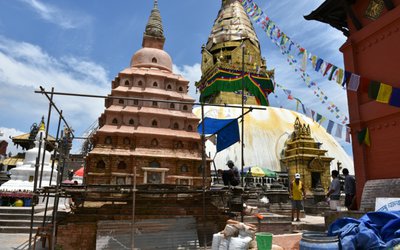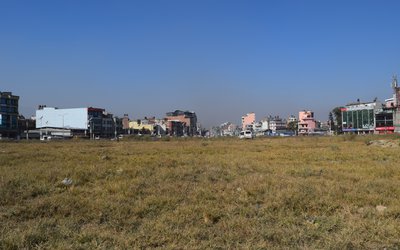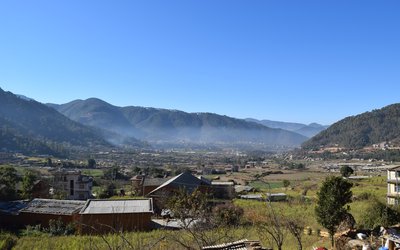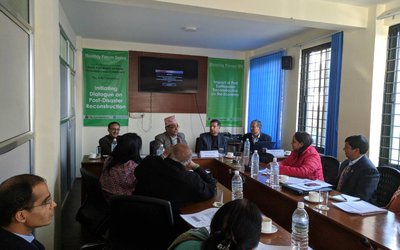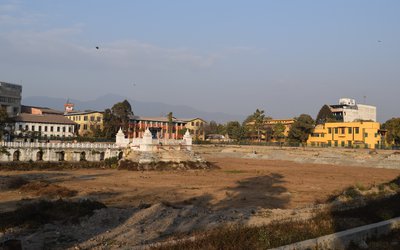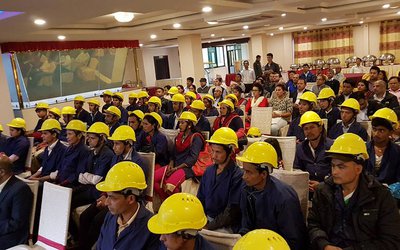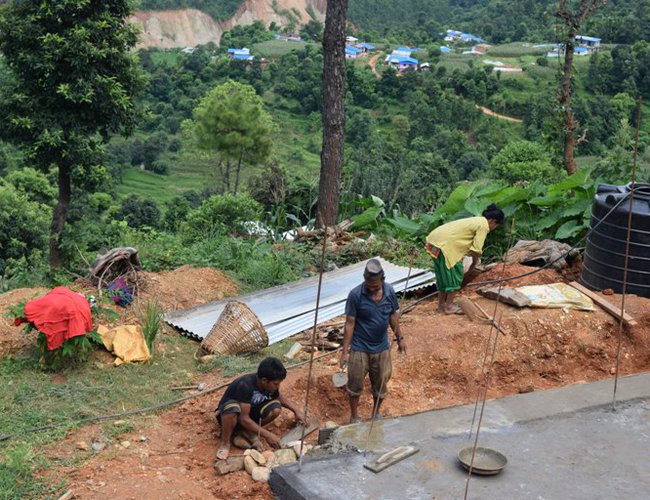
Now
nineteen years old, Rasmita Raut was a class ten student when the earthquake destroyed
her home in Khanigaun, Ward No. 3, of Baiteshwor Rural Municipality, Dolakha, and
150 kilometers east of the capital city of Kathmandu. Ask her about when her
home will be rebuilt, she does not know.
"My parents know that," says Rasmita, a 12th grader, who has been living in a temporary shelter for two years and a half since the earthquakes. Thousands of others, like Rasmita, are living in their temporary shelters.
Rasmita’s father had received Rs. 50,000, the first installment of grants for the victims of the earthquake, by signing an agreement in October 2016. He is yet to start the actual reconstruction.
“My father was saying that the money was very small given the prices of the construction materials and labor costs. He is now looking for other ways to secure additional money,” she said. "As the private money lenders charge high interest rates, my father is very cautious not to fall in the debt trap. I hope we will have a new home by next year.”
Shiva Prasad Neupane, 50, of Ward 5, Mailung Rural Municipality, Dolakha, has a different story to tell. He signed the contract agreement last October and received the first tranche. Neupane is now considering starting the reconstruction work only after the Dashain. “I have already spent the money for other purposes. The work got delayed because of the unavailability of masons, materials and additional money. Believe me I will start reconstruction from coming October,” said Neupane.
Out of 52,289 beneficiaries in Dolakha, 48,569 signed the agreement and 47,042 received the first installment. Even as many people like Rasmita and Neupane are planning to reconstruct their houses in Dolakha, only 9,233 took the second installment and only 628 the third.
Story of Kavrepalanchwok
Thula Kanchha Sarki, a
dalit, of Mundan-Deupur Municipality, Ward No 9, previously of the Mahadevsthan
Village Development Committee of Kavrepalanchwok district, has secured the first
and second installments and completed his home. However, Sarki is yet to get the
certification from the Project Implementation Unit of his municipality because
the house did not meet some technical requirements as prescribed by the NRA.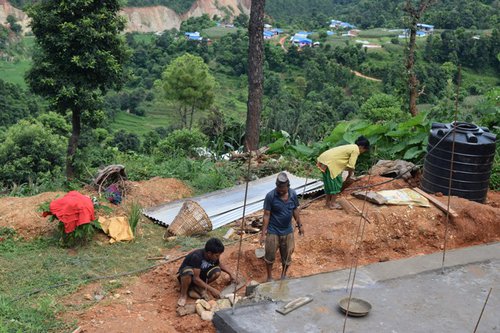
“I have already shifted to my new house following its completion, taking Rs. 400,000.00 in loan from a money lender at an interest rate of 20 percent per annum,” said Sarki. “I visited the Municipality and ward offices several times to meet their engineers and secure the third installment of Rs.100, 000.00 and the completion certificate. However, all my efforts went in vain. You may meet the God but not the engineer.”
Said Sarki: “I have built the house as per the model given by the Local Resource Center. The engineer visited my site during the time of excavation and foundation lying. Fed up with waiting for the engineers, I completed my house on my own. Now they have been declining the technical certification. Some middleman has come to my home and said I'd need to pay a hefty cash to get the certification.”
Journey To Reconstruction
For beneficiaries, the journey of signing the agreement and receiving the first installment begins from the Local Resources Center (LRC), which facilitates technical human resources necessary for supervising and inspecting housing and community infrastructure, masons and technician training, information on trained masons and technicians, social mobilization support, technical information and assistance for reconstruction, banking services and construction materials. It also has the grievance redress system.
LRC is the bottom institution of the CL-PIU in the Ministry of Federal and Local Development (MoFALD). The unit is responsible for government housing financial assistance distribution, grievance handling, social mobilization and communication with local authorities.
There is another institution as well. A District Level Project Implementation Unit (DL-PIU) for rural housing is established within the MoUD, DUDBC District Division Office, to coordinate with partner organizations and Local Resource Centers (LRCs) for technical assistance implementation, monitoring and inspection of reconstruction of rural housing.
NRA guidelines say engineers and/or sub-engineers, at least one each, are appointed in every Rural Municipality for approval of designs, inspection of phase-wise construction, to provide technical advice and also to inspect community infrastructure reconstruction.
With the restructuring of the local level and change of nature of institutional structures and border, some families have to travel for several days to reach local government offices to sign up for the compensation they have been promised. As all the LRCs are in the process of restructuring, this is not supporting the acceleration of the reconstruction drive.
Shortage of Technical Staffs
However, technical staffs are like endangered species. Newly elected ward chairman of Ward No. 9 of Mundan Deupur Municipality Jeet Bahadur Tamang accepts the fact that there is a shortage of technicians. “We don’t have enough engineers in our municipality and we are unable to monitor and certify all the houses under construction,” said Tamang.
With stringent technical requirements attached to the second and third installments, many beneficiaries, who completed the groundwork to qualify for the second and third installment of grant, are yet to receive the certification because of lack of technicians.
In the name of constructing earthquake resilient and safe houses under Nepal Rural Housing Reconstruction Program (RHPP), NRA engineers enjoy a monopoly in certification. Had NRA allowed all the engineers with registration from Nepal Engineering Council to do that work, more people would have come for the second and third installments.
Mayor of Namobuddha Municipality of Kavrepalanchwok district Tanka Prasad Sharma agrees that the lack of engineers and overseers is obstructing the process of distribution of grant of second and third tranches for the people who qualify. “I cannot rule out the possibility of wrong practices if the monopoly of the authorities remains in certification.”
Even as the monsoon rain is gradually receding and the third harsh winter is approaching, forty-six years old Damai Sarki of formerly Mahadevbeshi Village Development Committee, Ward No.3, and now Mandan Deupur Municipality, Ward No. 9, is in a rush to complete his house. He has already completed excavation and foundation works. However, he doesn’t know how soon an engineer will visit his site and certify his qualification for the second installment.
"In
consultation with and approval of engineers from the Center, I have started excavation
and foundation work. I don’t know whether I will get the technical
certification for the second part,” said Sarki.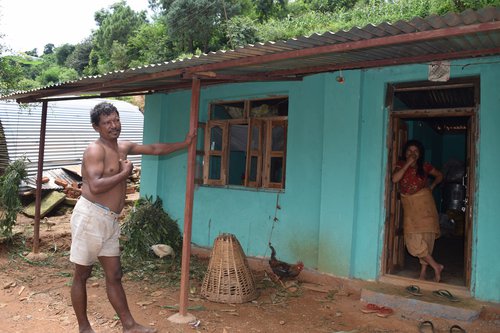
Out of 72,211 houses in Kavrepalanchwok, 63,870 signed the agreement and received the first installment. Only 5,247, however, received the second installment and just 79 beneficiaries received the third, including 64 with INGOs.
If there is a lack of technical manpower, there is a risk that people will not be able to afford to rebuild according to the government guidelines for earthquake-resilient homes. Sarki of Kavrepalanchwok has already shown what will be likely for the coming days.
“We are receiving complaints about the technicians. Municipality will take the issue with NRA to depute more technical manpower in the reconstruction areas,” said Jeet Bahadur Tamang, chairman of Ward No. 9 of Mundan-Deupur Municipality.
With 31 districts, 14 declared severely damaged and 14 less affected, Ministry of Urban Development has been mobilizing a total of 2,650 technicians in the most quake-hit districts.
The technicians have their own grievances. They complain that the government is reluctant to implement the agreement. The engineers went on a strike in December 2016 demanding their payment as per the agreement. Engineers complained that there was no performance standard in place and demanded that the employees mobilized in the reconstruction activities in villages should be provided with adequate remuneration.
“Due to the lack of trained human resources and cumbersome procedures related to grant distribution, among other factors, there has been low disbursement of housing grant,” said Kishor Maharjan, assistant professor at Tribhuvan University, addressing a discussion titled ‘Expenditure Analysis and Tracking of Post-Earthquake Reconstruction Programs,' organized by SWATEE with support from The Asia Foundation.
Kathmandu’s Experiences
Kanchhi
Tamang, 80, a resident of Masine Village, formerly Badbhanjyang Village
Development Committee, Ward No. 4, and now Chandragiri Municipality, Ward No. 10,
also received the first installment Rs. 50,000.00 last September just a few
days before Dashain. However, she does not say anything about where the money
went, only indicating that her family used the grant money to celebrate the festival.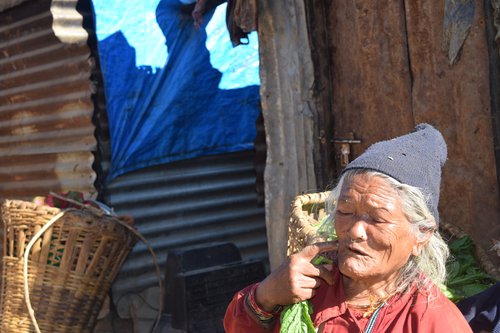
“The grant money was not enough even to clear the debris of the devastated house. Forget about doing the excavation and laying the foundation,” said Kanchhi. “We will start the construction soon and go for the second instilment after Dashain.”
In Masine, not all the people, who received the first part in September/October 2016, know when they will fulfill the requirements to apply for the second installment.
Thirty-two years old Surendra Tamang also received the first part of the money in October along with 100 other residents of his ward. “Constructing the house cost almost a million rupees. I spent the first tranche to clear the debris and to celebrate the festival. I have managed the money from elsewhere and I will start reconstruction after the Dashain.”
Given the present prices of materials and labor costs, the reconstruction grant would not be enough to build a house as prescribed by NRA and the challenges before the beneficiaries is to go for other sources to build the house while meeting the NRA guidelines.
Out of 45,295 in Kathmandu, 35,951 signed the contract and 35,490 received the first tranche and 658 the second and no one the third.
This indicates that there is a big gap in the beneficiaries signing the agreement and receiving the first, second and third tranches. Given the current system of inspection and certification, it will take a lot of time to end the gap.
People need more money to rebuild their homes than is provided through the cash grant. As they generally do not have access to low-interest loan schemes—seemingly due to the reluctance of private banks to provide the money, many poor rural victims, who received the first installment, fail to start reconstruction.
The money does not mean to cover the cost of new house construction. It is just a small part of the contribution from the government to build strong and earthquake resilient houses.
“People are not taking the second installment for houses because it is overloaded with technical and administrative requirements,” said Jagadish C. Pokharel, Ph.D, former vice-chairman of the National Planning Commission in a program organized by SAWTEE in association with The Asia Foundation.
“House is a social product. Several things determine it as the desire to build a house is not only a physical output. Beneficiaries are not interested in the second installment because there is too much bureaucratic hassle. The poor are poor, so they cannot take the advantage and the rich do not value it,” said Pokharel, presenting his paper on Nepal Post Disaster Reconstruction Experience: Current Status and Lessons Learnt. “The progress is slow because of engineering design, code, technology and conditions as well.”
A Tale Of Two Tales
At a time when the NRA-led
reconstruction is going on in a slow pace, INGOs, in relatively small numbers
and few villages, are making a big progress. They have already signed agreement
with 2585 people for the third installment. Main areas include Sinhdupalchowk
169, Nuwakot 283, Ramechhap 241, Dolakha 522, Rasuwa 444, Makawanpur 577 and
Lalitpur 272.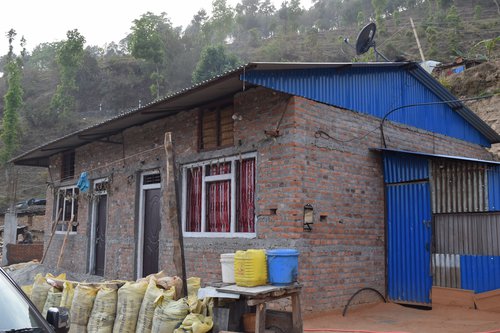
This shows that the success rate of INGOs is higher than that of the NRA. Equipped with adequate technicians to inspect the standards set by NRA and providing in kind support, instead of money, for reconstruction, INGOs are moving farther ahead.
As all the INGOs have also been providing technical assistance and asking the community contribution, the building construction pace has made a good progress.
“NRA is too bureaucratic and too centralized. NRA could not understand that earthquake response is humanitarian emergency response that needed to fast-track decisions and support system. NRA implementation is even slower than community development works during normal period. This is the reason why most of the houses under the government grant support have not been completed today,” said Dr. Prabin Manandhar, country director, The Lutheran World Foundation and former Chair of Association of International NGOs in Nepal (AIN).
Where The Money Goes?
Under an agreement signed by NRA with associations of commercial development banks and the financial associations to facilitating the transfer of grants through the banking system, the banks open the account of the beneficiaries.
NRA has already transferred over NRs 13 billion to the District Development Committees (DDCs) through the Central Level Project Implementation Unit (CL-PIU) at the Ministry of Federal Affairs and Local Development (MoFALD).
Once the individuals sign the grant agreement with their citizenship certificate, activating their individual accounts, they will receive the money. As most of the banks report that an overwhelming number of beneficiaries withdraw the money from the banks within a week of deposit, very few people have the money in the bank account. Last October, Nepal’s banking sector received a deposit of almost 6 billion rupees in earthquake affected areas. However, the money was withdrawn in a matter of a month.
“It is necessary to
find out whether the beneficiaries have received the first tranche and spent
the money on consumption or on laying the foundation of their houses,” said Murari
Niraula, Member Secretary, Public Expenditure and Financial Accountability
(PEFA) Secretariat under Ministry of Finance, referring to the dismal rate of
receipt of the second tranche of the housing reconstruction grant.![]()
“If we can track the bank accounts of the beneficiaries who have yet to start construction to see whether the money is still in the account, then we can infer that the procedures related to the fund allocation are indeed a problem,” Niraula added.
“Frankly speaking, as people receive the money just a week before Dashain, most of them spent the money to purchase foods and clothes,” said Neupane, a beneficiary resident of Mailung Rural Municipality.
There are 996,162 registered victims. The number of registered beneficiaries, however, is 765,618. By August 16, 2017, 632,045 signed the agreement and 603,072 received the first tranche, 56,687 second tranche and 2877 the third. According to NRA, 117,765 houses are currently under construction.
According to Nepal’s financial laws, if the money earmarked under the annual budget is used for purposes other than prescribed, the beneficiary is liable to punishment. If proper evidence is not presented in the next national audit, the money will be placed in unsettled account by the Auditor General's Office.
“The government is vigilantly tracking the distribution process and rectifying problems whenever necessary,” said Financial Comptroller General Rajendra Prasad Nepal.
Role of Local Level Representatives
Against the expectation of the policymakers that the situation will improve following the local level election, the activities of the elected representatives over the last four months are frustrating.
Instead of persuading people to build safe houses and use the private housing grant, the elected representatives are defending the people, who misused the first installment.
One cannot rule out the
entry of fake beneficiaries through elected representatives who are considering
themselves to be the government, with complete control over all the activities,
including reconstruction.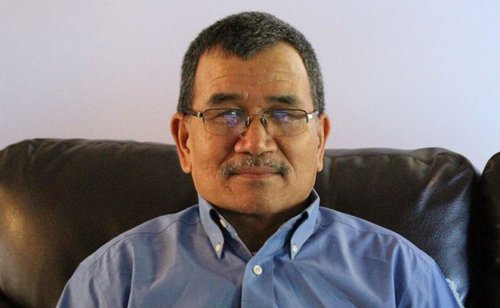
“There is a certain clash of interest between NRA and us. We are the representatives of the people and we cannot speak harsh words as other officials do,” told Chiribabu Maharjan, mayor of Lalitpur Metropolis to New Spotlight.
District officials express frustration saying that the elected representatives are acting as if they are more powerful than the prime minister. “Instead of supporting us to identify the genuine beneficiaries, local leaders are putting the pressure to include all in the name list,” said a senior official at the Ministry of Federal Affairs and Local Development. “If elected leaders support us, the drive can move fast. Given the present response, there is less hope,” said a DDC official of Kavrepalanchwok on condition of anonymity.
“Local leaders can play an important role to check fraudulent acts and duplicate registration,” said Padmini Pradhananga, general secretary at Transparency International.
New Deadline
Releasing the necessary budget for private housing grant to the central project implementation unit (CPIU) under the Ministry of Federal Affairs and Local Development, the NRA has set the deadline of a year for the reconstruction of private housing.
“NRA has released the budget early to not allow the inadequacy of money for first, second and third tranches of grants distribution in the earthquake affected districts,” said Yam Lal Bhoosal, spokesperson of the NRA.
In a recent meeting of Development Committee of Legislature Parliament, members of the committee expressed the concern over the lack of technical manpower, stringent technical criteria, and administrative hassles attached with private house reconstruction with Chief Executive Officer of National Reconstruction Authority (NRA) Professor Dr. Govinda Raj Pokharel.
“Yes, there were certain procedural hassles due to lack of technical manpower as well as in providing certification. However, the recent amendment of Quake Affected Private House Reconstruction Grant Distribution Guideline 2073 addresses the people’s concern and it will accelerate the reconstruction process from now on,” said CEO Professor Dr. Pokharel. “We will complete the reconstruction of private houses by next year and those eligible will receive the grant without any hassle.”
Flaws In Identification
As the process of grant cash agreement has reached in different stages in various districts, NRA is still settling the complaints in identifying the beneficiaries. It has dispatched 332 engineers in 14 severely affected districts to re-survey about 128,000 houses of those who filed complaints to NRA as being left out.
According
to National Reconstruction Authority, this team of engineers, who will use GPS
data systems, will determine the beneficiaries’ status and present the report
by September 16. There are 207,500 pending complaints with NRA. According to
NRA, it will take a final decision on all complaints by October 17.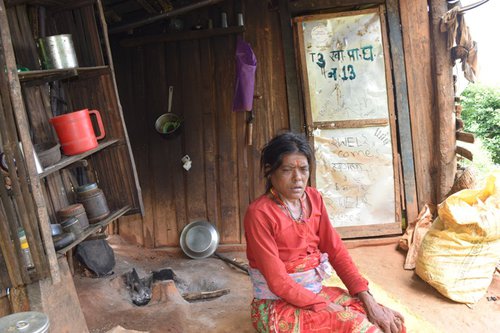
From the very initial phase, there were many flaws in the criteria of identifying the beneficiary. Just a week after earthquake, the government asked local bodies with support from an all-party mechanism to assess the damage and destruction.
Following this survey, identification cards were issued in two categories, red card for severely damaged house family and yellow card for partially damaged house family.
The second intensive assessment was conducted by District Disaster Relief Fund with assistance from engineers. This data formed the base to issue the identity cards. This was when many fraudulent activities occurred with wrong data assessments. Large numbers of people registered complaints against the second assessment. Media reports said that the database was a result of manipulated by politicians and there were also incidents of corruption.
“Because of the direct link with aid provisions and the disorganized way they were conducted in many locations, the assessments became a significant source of contention throughout all earthquake-affected districts,” points out a study report, Nepal Government Distribution of Earthquake Reconstruction Cash Grants for Private House by The Asia Foundation and Democracy Resource Center.
As the assessment was made in an inconsistent manner, a process emerged whereby beneficiary lists were adjusted and readjusted based on new data and incoming complaints again and again.
Conducted by Central Bureau of Statistics, CBS, with more scientific methods, the recent database too is not free of complaints. The recent decision of NRA to dispatch another team for searching the missing shows even this report is contentious.
“We have been saying from the very early days that there was manipulation in the registration and issuing of identification cards. Low disbursement of the second tranche of housing grants was only to be expected as there were many cases of fraudulent and duplicitous registration,” said Padmini Pradhananga, General Secretary of Transparency International Nepal. “We are closely monitoring the accountability and transparency part in all earthquake affected districts.”
Distrust And Mistrust
There is a trust deficit between the government and beneficiaries. The government placed so many stringent components attached with the grants on a suspicion that the people will misuse the money. People too didn’t trust the government and took the construction on their own.
Against the background of rampant poverty and low awareness level, rumors travel from various sources, preventing the people to work with confidence. Last year there was a big rumor that said the government was distributing Rs. 800,000.00.
In Kavrepalanchwok many villagers had withdrawn their applications from the beneficiary's list of the Lutheran World Federation, a humanitarian INGO, for building the houses for poor, dalits, elderly, single women and marginalized community.
With the rumor spreading in the village, Thulakanchha Sarki and Damai Sarki came to withdraw their application from LWF. "I withdrew the application from LWF to get a big free grant. The result is: many of my neighbors have moved to new houses and I am still in the temporary shelter waiting for the second installment from NRA,” said Sarki.
Safe House Unsafe Process
In
order to get people back into safer, permanent housing, government and major
donors developed the Nepal Rural Housing Reconstruction Program (RHRP). Through
this program, reconstruction cash grants, disbursed in three tranches, are
provided to eligible beneficiaries to aid them in building earthquake-resistant
houses.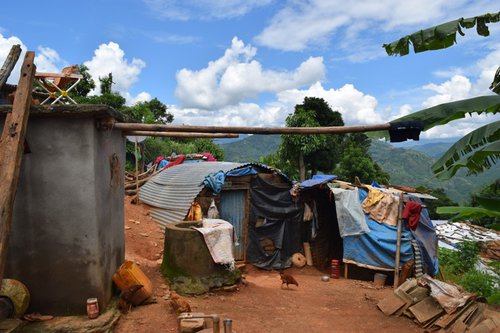
“There is a certain gap in the technical as well as procedural side,” said Lakshmeshwor Mahato, Program Manager, Smaritan’s Purse, an INGO working in the reconstruction of houses to poor, marginalized, single women, elderly in Kavrepalanchwok district under NRA’s recommendations and guidelines.
Amendment Beneficiaries
The distribution of second installment had been halted due to the delay in approval of the amended Guidelines on grant distribution to private houses, 2072, which was finally endorsed by the cabinet on December 29, 2016. It opens the doors for the distribution of the second installment and addressing some genuine issues of landless.
Krishna Awale, of Chochhe of Lalitpur Metropolitan Ward No. 10 is a beneficiary of the amendment. Awale demolished his damaged house two years ago but did not have access to money as his land was a collective of his family. Now he can claim Rs. 200,000.000 to purchase the land for his new house with the recommendation of the elected representatives.
“Since ours is an ancestral house and it is a common property of four of us and I don’t have any single land ownership certificate of the land where I have been living for my whole life," said Awale.
Fifty five years old Kali Mijar, a divorcee, who was unable to access the rebuilding funds because she had no land ownership certificate, can also get the fund. A resident of formerly Mahadevsthan Village Development Committee of Kavrepalanchwok district, she had been married as a child and her husband went at large with another woman. In Nepal, women obtain land ownership paper through their fathers or husbands. Having neither, Kali was unable to access the government relief funds.
“The process is delayed because its details were prepared by the center ignoring the local reality. For months, it was unclear what kinds of houses people would be allowed to rebuild,” says Min Bahadur Shahi, the convener of the Humanitarian Accountability Monitoring Initiative, a collective of local NGOs.
Along with procedural complications, the delay also occurred due to promulgation of constitution followed by a violent confrontation and blockade of almost six months.
Lack Of Information
Part of the problem has been the lack of transparency, accountability and information for the general public on how the process of reconstruction should proceed. Whether it is making sure that people understand the timeline for compensation disbursements or knowing where to go for help, the government must be transparent and proactive in communication. The lack of information has been a major challenge for many Nepalis, especially the poor and the disadvantaged.
As tens of thousands of earthquake victims have already faced a third monsoon living in temporary shelters and waiting for a harsh winter and the country is heading for another round of elections for national and provincial parliament, newly restructured local bodies, lengthy process, lack of technical manpower, flaws in identification and lust for money are making Nepal’s entire reconstruction process uncertain.
“Who controls the
process becomes a politically sensitive issue. Controlling $9 billion plus
project naturally blows up the problems and ignites political chords,” said Dr.
Pokharel. "Unclear policy leads to misunderstanding and misplaced demands
and expectations on the part of people. The issue of 'compensation vs. relief'
or 'right vs. privilege' should be understood clearly while making
interventions."
What is required is the need for people and government to look at each other as complementary and supplementary in the reconstruction process. Only then will the whole thing move forward in tandem.
“Reconstruction Pace Picking UP” Yam Lal Bhoosal
Young and dynamic,
joint secretary Yam Lal Bhoosal is the spokesperson of the National
Reconstruction Authority. As a hard working bureaucrat, Bhoosal spoke to New
Spotlight in response to the complaints about the lackluster reconstruction
process and on various related issues. Excerpts: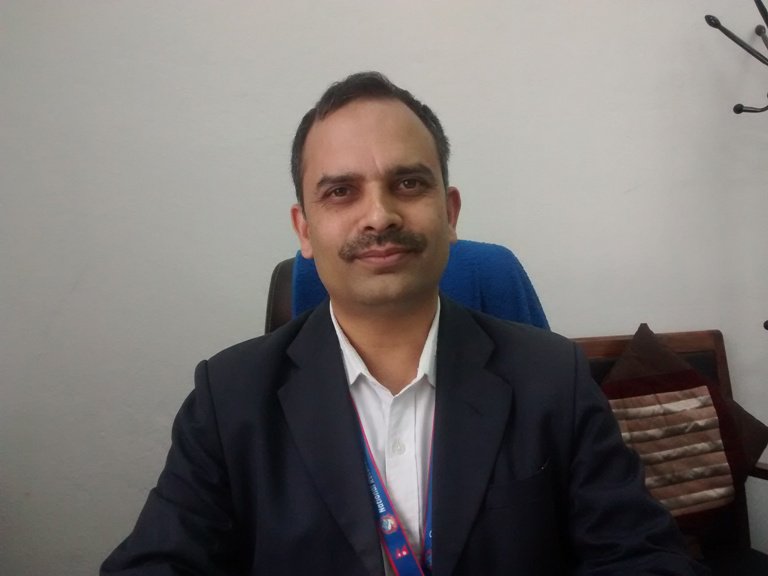
There
are complaints over the delay in the reconstruction process. Is the delay due
to the procedures or something else?
It is true that the reconstruction process was initially slow due to various factors. One of the major factors was said to be the regulations related to reconstruction. We don’t need to panic now as the situation is very encouraging. With the amendment of Private Housing Grant Rule, the pace of reconstruction has taken off. We have amended certain procedures as well.
How about the state?
We have already signed agreements with over 632,000 beneficiaries and over 630,000 beneficiaries have already received the first installment and about 57,000 have received the second installment. We have already set our target to complete the reconstruction of private houses within this fiscal year. The recently held NRA's steering committee meeting under the chairmanship of Prime Minister Sher Bahadur Deuba has directed us to complete the reconstruction of private houses. We are strictly following this. We will move ahead correcting our shortcomings.
Do you think, after the amendment of rule, the process has been easier?
After the amendment, many clauses, which created obstructions, were removed or new clauses were added to facilitate the process of reconstruction of private houses to take speed. We have been speeding up the reconstruction process and to make to smooth. After this, there are certain changes in the process to go from center to Central Level Project Implementation Unit (CLPIU) and then District Level Project Coordinative Units, Rural Municipality and Ward unit for authentication. With the approach of decentralization, we directed all concerned authorities to take the decision at the spot.
How about the delay in the inspection and certification by engineers?
After the election of local bodies, all the technical staff, including engineers, are under their direct control. We think the process of certification will accelerate.
How about the local level elected representatives?
NRA also is in the process of developing a working guideline to mobilize elected local representatives to accelerate post-earthquake recovery and reconstruction work from the beginning of fiscal year 2017-18.
What about the persons without land ownership documents?
The persons registered as beneficiary will get the grant. If a person is landless, he or she will get Rs. 200,000.00 in grants under the recommendation of local level. We are collecting the data of such persons. We have now the data system to see the people.
There are also reports that the technical staff are demanding hefty money with people to issue certification. How do you look at this?
We have zero tolerance on corruption. If we receive complaints, we will take the necessary action. In some incidents, we have receive complaints that engineers are not certifying the work to go for the second round. UNDP is supporting NRA in the process of improvement of the houses if the base is not made properly.
Why are the construction activities delayed?
The reconstruction activities, basically, that of housing, has failed to pick up speed due to various reasons, including confusion among housing grant beneficiaries, and lack of motivation, among others. NRA plans to use elected local representatives of the government to give housing reconstruction a boost and facilitate related activities at the local level.
Who are you going to mobilize?
NRA basically plans to mobilize mayors, deputy mayors, chiefs and deputy chiefs of rural municipalities across Nepal in the reconstruction process.
How do you look at the delay in work?
The slow pace of post-quake reconstruction is also due to lack of proper guidance for earthquake victims in rebuilding the damaged physical infrastructure. Local level representatives can play a crucial role to motivate, encourage and assist the local level reconstruction activities.
While two years have already passed since the devastating earthquake rattled the country, the road to recovery has been an uphill climb. What do you want to say?
As I mentioned, the process will accelerate now. NRA has been making all its efforts.
It is reported that NRA stopped issuing the second tranches, why?
The second tranche of housing grant has been denied temporarily to almost 6,000 beneficiaries out of 55,000 applications received as they had not complied with building codes. They could be eligible if they made the necessary modifications as advised.
What do you say of the pace?
According to our information, over 116,000 people have started building houses and 55,000 have already received second tranches and another 16,000 are in the process to receive the second tranche. Just after summer, in coordination with the elected local level, we will complete the reconstruction by next year.
Read PDF Version: Earth Quake Reconstruction Laws and Flaws PDF Page 25-33.pdf
This publication has been supported by The Asia Foundation. The contents of this publication reflect the views of the author(s), researcher(s), and contributing editor(s) and do not necessarily reflect the views of The Asia Foundation.

Keshab Poudel
Poudel is the editor of New Spotlight Magazine.
- ECONOMY: Growth At 3.3
- Apr 16, 2024
- DPM’s SHRESTHA’S CHINA VISIT High Profile, Low Key
- Apr 14, 2024
- Maha Kumbha In Barahkshetra: A Sacred Festival In Sacred Koshi (Kaushiki) River
- Apr 09, 2024
- LOSS AND DAMAGE: Upper Tamakoshi A Case
- Apr 02, 2024
- Helvetas-Nepal’s InElam Promoting Herbal Oil In Sarlahi
- Mar 31, 2024

